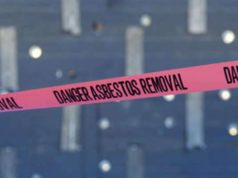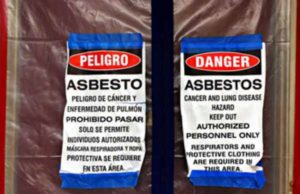
What is Chrysotile Asbestos?
Chrysotile asbestos is by far the most common asbestos material found in the US and is responsible for the lion’s share of asbestos related claims and injuries. It is a soft greyish green mineral with a fibrous nature. Its fibrous nature means that the material is actually made up of many smaller fibers that are easily separated. This brittleness helps to break the mineral down into micro particles, where it is easily inhaled by suspecting victims. The heat resistances of Chrysotile asbestos is very high, hence it common practical application as an insulator prior to the dangers of the mineral being found.
The chemical compound of Chrysotile asbestos is:
Mg3 (Si2O5) (OH)4
Some iron ions may be found within the structure as well.
Why was Chrysotile asbestos so widely used?
Chrysotile asbestos became the most widely form of asbestos due to its high flexibility and fine texture. This made is significantly easier to work with that its more brittle counterparts. Estimates are 90% of asbestos used in the United States was a form of Chrysotile asbestos. You can find Chrysotile asbestos in automotive parts such as brake pads, roofing materials and insulation. Sealants and paints may also contain Chrysotile asbestos and these represent the greatest risk, due to the fact that older applications are prone to chipping and forming a toxic dust. Just as lead dust from older paint jobs has caused serious health issues, one can be exposed to Chrysotile asbestos in the same way.
How much exposure to Chrysotile asbestos is too much?
Once the Chrysotile asbestos adheres to lung tissue, it is not dislodged. All will eventually come into contact with naturally occurring asbestos, but not in concentrations serious enough to cause complications. Those that live in buildings insulated with asbestos are at risk if this insulation is disturbed or exposed will face daily exposure from Chrysotile asbestos particles. Those that have worked in industry or the armed forces, particularly before 1970, have likely been contaminated by asbestos particles.
Diseases and disorders from asbestos do not typically become apparent until about 40 – 50 years after exposure. This is one contributing factor to the slow realization of the dangers of asbestos. Only now, roughly a half century since the heyday of asbestos building materials, have victims of the hazardous material been able to win compensation.
What illnesses are caused by Chrysotile asbestos?
Mesothelioma – this is a cancer caused by asbestos that promotes malignant growth in the lining of the heart, lungs and diaphragm. Chrysotile asbestos crystals become embedded in these areas through normal breathing and the malignant growth occurs as the body cannot remove the foreign material.
Asbestosis – this disease is similar to emphysema and also involves the presence of asbestos in the lungs. Immigration occurs in the alveoli around the lining of the lungs and inflammation occurs when the body’s immune system cannot eliminate the Chrysotile asbestos crystals. The victim’s lungs will grow hard and impossible to expand and fluid will build up in side of them. They will struggle to breathe and there is no cure for this condition.
Is there a ban on Chrysotile and other forms of asbestos?
Although there are some restrictions and mandatory asbestos inspections in the United States, there is no comprehensive ban on asbestos. Employers are expected to practice due diligence when having their workers use asbestos, although the use of asbestos in the US has dropped dramatically after the health concerns became more readily known. Canada too, has no ban on Chrysotile asbestos and in fact remains one of the biggest producers of this form of asbestos.
What are laws related to Chrysotile asbestos?
The Occupational Safety and Health Administration sets many of the regulations related to asbestos exposure in the workplace. Although medical experts assert there is no “safe” level of asbestos exposure, the OHSA has noted that 0.1 fiber per cubic centimeter of air for no more than eight hours, is a “permissible exposure level.” Employees may not be rotated to skirt the PEL time limit and short term exposure may not exceed 1 fiber per cubic centimeter in less than 30 minutes. Shipyards and workplaces undergoing abatement of asbestos materials must follow this regulation.
Employers are now required by law to provide adequate training to those that will be working with asbestos. This is part of the standard of care that employers have to their employees. Breaching this or failing to adhere to the law will lead to litigation and possible criminal prosecution. Training is divided by four classes and is sorted based on the type of abatement being done on the structure.
Class I – (most severe) removal of confirmed or presumed asbestos laced thermal insulation or sprayed on asbestos coating
Class II – removal of non-insulation building materials containing asbestos, such as flooring and roofing materials
Class III – repairs and maintenance where there is the possibility that existing asbestos may be disrupted
Class IV – (least severe) cleaning up asbestos containing waste
Those in Class I and II are monitored are monitored carefully for their total exposure
Additional statutes relating to Chrysotile asbestos exposure include
29 CFR 1926.1101 – construction work and renovations on asbestos containing structures
29 CFR 1915.1001 – asbestos exposure in shipyards
29 CFR 1910.1001 – asbestos exposure in industry
Among the provisions of these statutes, decontamination areas must be provided for workers and training sessions but be given to inform workers on the dangers of the materials they will be working with. Most importantly, any employees working in an area prone to possible exposure must have records kept on their health for thirty years after the risk of exposure is over.
Chrysotile asbestos litigation
For those that have developed an asbestos related illness, there is a legal remedy that will win damages to cover medical expenses and other losses sustained from having that preventable illness. One may pursue asbestos litigation only if they develop a disease, not if they are exposed, but show no signs of illness. With the aid of a Chrysotile asbestos litigation lawyer, you will be able to recover losses from missed work, lost wages and medical bills. Punitive damages against careless employers may also be in effect.




























